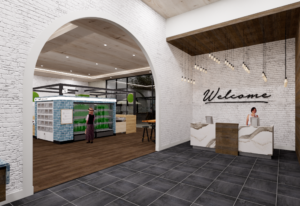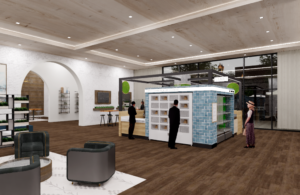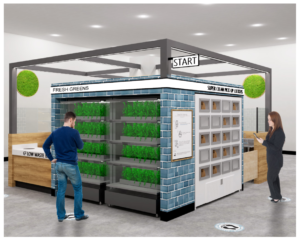SEATTLE – At the heart of her professional life, Melanie Corey-Ferrini, FCSI, NCARB has long been concerned with the fundamental elements of human existence, primarily shelter and food. Armed with an architecture degree from California Polytechnic, Pomona, Calif, she plied her trade early on with retail projects, as well as spaces designed for the food business.
 An entrepreneur at heart, Corey-Ferrini eventually started her own design firm (Dynamik Space) in 2000. As if that weren’t enough, she indulged her passion for food space design with the advent of 3.14dc. As lead creative at the Seattle-based 3.14dc, and with a newly minted certification from the Food Consultants Society International, the F&B side of her business life rapidly expanded.
An entrepreneur at heart, Corey-Ferrini eventually started her own design firm (Dynamik Space) in 2000. As if that weren’t enough, she indulged her passion for food space design with the advent of 3.14dc. As lead creative at the Seattle-based 3.14dc, and with a newly minted certification from the Food Consultants Society International, the F&B side of her business life rapidly expanded.
With projects at nearby Microsoft (Redmond, Wash.), Corey-Ferrini honed her craft, as well as her ability to find solutions to 21st century problems. “Sustainability was really important to Microsoft, as well as using local ingredients,” she says. “I developed an understanding of the food systems and how to source. In the last year or so, I’ve really started to get involved in indoor agriculture and what’s called controlled environment agriculture—growing your food inside buildings.”
Living, working, and eating are all part of the “built environment” and designing food spaces incorporates all facets of building and design. Opportunities for creativity are numerous, and it’s ultimately what motivated Corey-Ferrini to submit ideas for the Foodservice Pioneering Concept (FPC) competition, an annual tradition at HX: The Hotel Experience Powered by AAHOA. FPC judges evaluated all entrees looking for relevant, customer-focused, revenue-generating designs.
 Corey-Ferrini – lead (3.14dc) and Joshua D. Mass (elite studio) eventually crafted the winning concept, dubbed “G2.” G2 separates itself from the competition by providing a wide demographic of customers with an experience altogether different from the kiosk style-lobby pop-up. It’s not simply a small footprint, touchless fast casual model either.
Corey-Ferrini – lead (3.14dc) and Joshua D. Mass (elite studio) eventually crafted the winning concept, dubbed “G2.” G2 separates itself from the competition by providing a wide demographic of customers with an experience altogether different from the kiosk style-lobby pop-up. It’s not simply a small footprint, touchless fast casual model either.
“The menu is designed to engage customers from breakfast to dinner,” explains Corey-Ferrini. “The integrated indoor urban grow garden, along with fresh plant-based experience and nutritional offerings of greens, protein rich grains, and customizable add-ons of veggies, roots, and dairy, is easy to integrate into any location. The bowls offer something for all ages, with the specialty seasonings as an added bonus, the more adult palette will appreciate the depth of flavors.”
 The menu does not require a hood and uses plug n’play countertop equipment. The layout and design of the perimeter wall and metal box channels (with integrated LED tape lighting) makes the concept easy to create as a modular kit of parts that can be fabricated off-site and bolted in place. Self-contained sinks can accommodate locations with no direct water connections.
The menu does not require a hood and uses plug n’play countertop equipment. The layout and design of the perimeter wall and metal box channels (with integrated LED tape lighting) makes the concept easy to create as a modular kit of parts that can be fabricated off-site and bolted in place. Self-contained sinks can accommodate locations with no direct water connections.
“Rather than spending time ordering from a manned order station, the customer is asked to engage in the nutrient rich mobile app,” Corey-Ferrini explains. “A custom G2 bowl is ordered. The making of the bowl is fully transparent, and once complete is put into a UV-cleaned touch-less locker. The container is a compostable low waste solution.”
The concept is multi-faceted, and could offer owners different ways of making money, beyond simply selling what’s on the menu. “Maybe you could sell some new types of greens and you could have cooking classes, or even a farmers’ market,” Corey-Ferrini adds. “If you have different means of making money, you’re going to be more resilient in a down-turn of any kind.
 “You’re growing your own greens right there, so maybe you sell the greens separately,” she continues. “It’s an easy menu concept to be touch-less, and the locker system works well. You hold it from the back of the locker, the customer picks up from the front. It’s got a small footprint. The mechanical, electrical, and plumbing—depending on the jurisdiction, is a lot easier. And indoor ventilation is not even needed.”
“You’re growing your own greens right there, so maybe you sell the greens separately,” she continues. “It’s an easy menu concept to be touch-less, and the locker system works well. You hold it from the back of the locker, the customer picks up from the front. It’s got a small footprint. The mechanical, electrical, and plumbing—depending on the jurisdiction, is a lot easier. And indoor ventilation is not even needed.”
All FPC entrants were challenged to conceive, create, and rough-design their most edgy idea for:
• a revenue-generating foodservice concept that can open and operate in an under-used, nontraditional location in a hotel or resort;
• lobbies, courtyards, hallways, concourses or any high-traffic space not specifically outfitted to foodservice; and
• locations where access to water is limited and ventilation and gas connections are non-existent.
